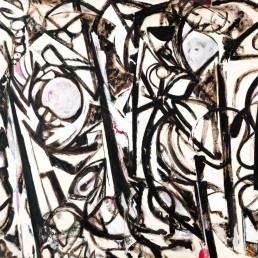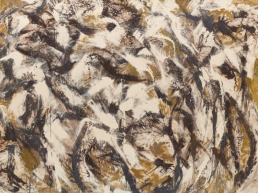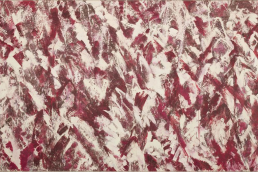
“I think all painting is biographical. You can read any artist, if you take the trouble to.” – Lee Krasner
Artland’s Lost (and Found) Artist Series focuses on artists who were originally omitted from the mainstream art canon or largely invisible for most of their career. This edition’s featured artist is female Abstract Expressionist Lee Krasner. A formidable painter, Krasner was long cast under the shadow of her husband Jackson Pollock. Even today, she is not nearly as well known as Pollock and other contemporaries like Willem de Kooning and Mark Rothko.
Lee Krasner
2019 marks an important milestone for Lee Krasner. A major retrospective of her art opened at London’s Barbican Art Gallery on 30 May 2019, and will run through 1 September 2019. It’s the first large-scale Lee Krasner exhibition in Europe since the 1960s. Nearly 100 works are on view, many of which have never before been shown in the UK.
For years, Lee Krasner’s incredible contribution to Abstract Expressionist art was overshadowed by her husband Jackson Pollock. However, her art was a force to be reckoned with in its own right. She worked steadily alongside Pollock in their Long Island home, and continued unwaveringly after his death. What with navigating the complexities of life and love with Pollock, a notorious alcoholic, and fighting for her place as a female artist in a male-dominated art world, Krasner did not have it easy. She was 75 years old when she finally received her first American retrospective at the Houston Museum of Fine Arts in 1983. We trace the story of one of Abstract Expressionism’s most inspiring artists and examine how her artworks have been received throughout the decades.
Lee Krasner’s Journey Towards Art
Born in New York City in 1908, Lee Krasner was the daughter of Russian Jews who had fled to New York from their shtetl outside Odessa. From an early age, Krasner knew she wanted to pursue art and she managed to attend the only public school that offered an art course for girls. She then studied at the Art Students League in New York and gained practical experience working on the Works Progress Administration murals, book illustrations and other public art projects in the 1930s. During this program, initiated by President Roosevelt to help artists during the Depression era make ends meet, she met fellow artists Stuart Davis, Ad Reinhardt and Willem de Kooning, who would soon become leading Abstract Expressionists. Then, in 1937, she studied for three years under Hans Hofmann, an artist who had known Matisse, Mondrian and Kandinsky. Under his guidance, Krasner started creating abstract paintings inspired by Picasso’s Cubist works and Mondrian’s geometric compositions. Krasner referred to her works from this period as her “grey slab paintings.”



Lee Krasner and Jackson Pollock – Long Island
In 1942, Krasner visited Jackson Pollock at his studio. She had seen his works as they were exhibited alongside each other at the McMillan Gallery and was deeply inspired. Three years later, they were married and moved to a farmhouse on Long Island. Krasner had organised a $2000 loan from Peggy Guggenheim so they could buy the house and devote themselves to painting in peace. The move was also an attempt to help Pollock rid himself of his crippling alcoholism.
During the first years of their marriage, Krasner worked on a series called “Little Images” (1946-1950) in her small studio upstairs. The paintings were filled with little symbols and marks arranged in grids. Meanwhile, Pollock was making his famous drip paintings in the barn, and was getting all the recognition. The two artists only ever entered each other’s studio space upon invitation. Though overshadowed by Pollock, Krasner was appreciated and respected by many of her peers and was also featured in Leo Castelli’s 1951 “Ninth Street Exhibition of Paintings and Sculpture.”
In 1956, Pollock got killed in a car crash. He had been driving drunk with his mistress Ruth Kligman and her friend Edith Metzger. Only Kligman survived the accident.
“Painting is not separate from life. It is one. It is like asking—do I want to live? My answer is yes—and I paint.” - Lee Krasner
The Umber Paintings
After Pollock’s death, Krasner almost immediately started painting again. Between 1959 and 1962, she created her “Umber Paintings”, with a palette restricted to browns, creams and whites. They are much larger in size than her previous paintings, and covered in dense, wild curves and slashes. Battling insomnia, Krasner decided to paint whenever she couldn’t sleep. She therefore chose not to work with colours since they were paintings created in insomniac nights. These paintings are some of her most psychologically intense, and she seems to have fully come into her own with this series.
Lee Krasner’s Cycles
There were many different cycles in Krasner’s artistic career. She liked to work in certain styles and then move on to something totally new. Self-portraiture, Cubism, mosaic, collage… these were all different ways of expressing her inner self. In November 1951, Robert Goodnough noted her surprising changes in her art: “Lee Krasner [at Betty Parsons Gallery in New York] has changed surprisingly from earlier, extremely intricate paintings and has turned to large, free abstractions which depend entirely on open areas of square, rectangular shapes and strips of color, these playing over the surface completely free of association. One comes away with the feeling of having been journeying through a vast uninhabited land of quiet color.” Throughout the ‘60s, her practice became more and more developed and free. Something about Pollock’s passing had, in a sense, liberated her as an artist.

Factors Contributing to the Underrecognition of Lee Krasner
Female artists in the 1940s and 1950s invariably had to face misogynist assumptions about female weakness and frivolity. It was simply much harder to be taken seriously as a woman artist. Furthermore, Krasner was somehow stuck in the gap between two generations of artists. There was the first generation of male Abstract Expressionists where she was too often just considered to be “Jackson Pollock’s wife.” Then, there was the next generation of female Abstract Expressionist artists who were depicted as the “glamorous female painters.” These included Helen Frankenthaler, Grace Hartigan, Elaine de Kooning and Joan Mitchell.
It has also been argued that she remained lesser-known due to the fact that she did not stick to one highly recognisable style like, for example, De Kooning and Rothko. Another issue is the fact that there are relatively few Lee Krasner works. She was a notoriously harsh self-critic and often destroyed her own canvases. Her nephew Jason McCoy, who is an art dealer, explains that there are enough works by her to establish her vision and power. However, to build a big reputation a large body of work is also often a requirement.

Lee Krasner’s Exhibitions
In 1965, the Whitechapel Gallery put on her first major international show. In 1973, Krasner was shown at the Whitney Biennial at the Whitney Museum of American Art. Then, in 1983, came her first American retrospective at the Houston Museum of Fine Arts in 1983. It travelled to the MoMA in 1984, but sadly, the exhibition opened just six months after Krasner died. Today, Krasner’s artistic legacy is being celebrated with the Barbican exhibition Lee Krasner: Living Colour. As stated by the Barbican: “Lee Krasner is a key figure in American art, whose energetic work reflects the spirit of possibility in post-war New York.”
